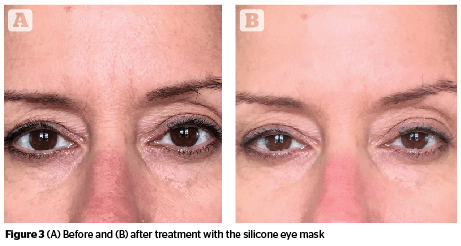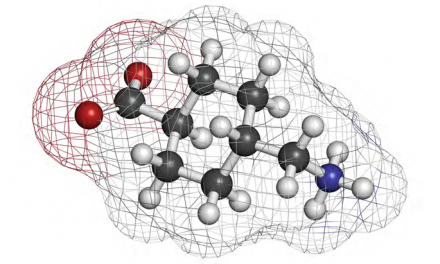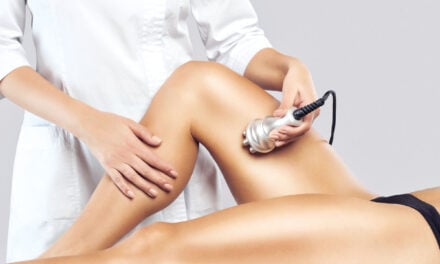Steven Harris, Ben Mathers, Don Othoro, and Saskia Sabelus discuss the results of their randomized, controlled comparative study between a silicone eye mask versus a regular eye mask in the reduction of glabellar lines and the
promotion of emotional relaxation.
Over 17,000 sensory receptors have been reported in the human face1. The response of the face to touch, or indentation of the skin is mediated via facial mechanoreceptors located in the superficial layers of skin. These may be divided into slowly adapting (SA) receptors firing with constant indentation of the skin and rapidly adapting (RA) receptors responding only to the onset and offset of indentation2.
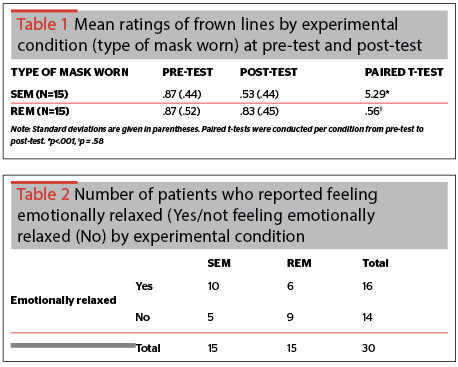
90% unmyelinated, SA4). Free nerve endings are the most common mechanoreceptors in the face and may be further divided equally into low-threshold pressure (LTP) units responding to light touch and high-threshold pressure (HTP) units responding to deep touch. RA receptors include Meissner corpuscles (RA1) and hair receptors(RA2)2,3.
It appears that stimulation of SA receptors involves not only the somatosensory pathways, but also the autonomic nervous
system (ANS)1,3. The trigeminal nerve, which carries sensory information to the central nervous system (CNS), in particular the hypothalamus, is accompanied by both sympathetic and parasympathetic fibres along its course1. Indeed, stimulation of SA receptors has been associated with pleasurable touch sensation as well as the lowering of sympathetic activity3. According to the model of hypothalamic tuning, vagal activity also leads towards more trophotropic tuning of the hypothalamus (via an autonomic loop) to produce a decrease in both global muscle tone and emotional arousal4.
The silicone eye mask (SEM) is an anti-wrinkle eye mask that employs small raised silicone dots situated on a raised inner portion; it is hypothesized that the silicone dots stimulate SA receptors to inhibit sympathetic activity via trophotropic tuning of the hypothalamus. The result is a reduction in both facial muscle tone (improving overlying facial lines) and emotional arousal. A study was conducted to compare the efficacy of the SEM versus a REM in the reduction of glabellar lines and the promotion of emotional relaxation.
Materials and methods
Study design and subjects
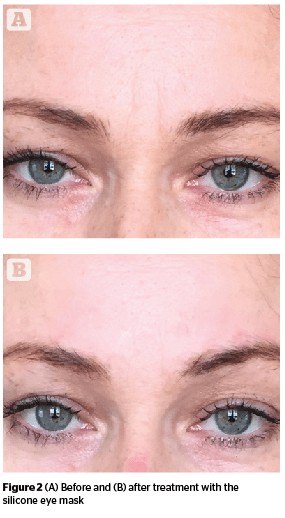
Study products
Subjects were randomly assigned to wear the silicone eye mask (SEM) (N=15), or a regular eye mask (REM) (N=15) for 15 minutes while lying down. The REM consisted of an outer and inner (face-side) layer of cotton drill with a middle layer of poly-cotton interlining. Two adjustable straps attached to the sides helped secure the mask to the face. The SEM was similar to the REM, but had small raised silicone dots positioned on the inner layer, itself raised by an interlining outline (Figure 1).
Assessments
The changes in appearance of glabellar lines were measured by expert visual grading of high-resolution digital images using a four point scale for frown lines with 0.5 grade increments (between 0–3), at baseline and 15 minutes after wearing the mask (REM or SEM); then hourly for up to 5 hours. Two trained external expert graders who were blinded to the treatments, independently assessed the changes by comparing baseline and post-treatment images side-by-side (using the four point scale for frown lines).
Emotional relaxation was assessed immediately before and after 15 minutes of wearing the mask (REM or SEM) by self-assessment using a patient questionnaire (0=not relaxed, 1=relaxed) before and after wearing the mask for 15 minutes.
Results
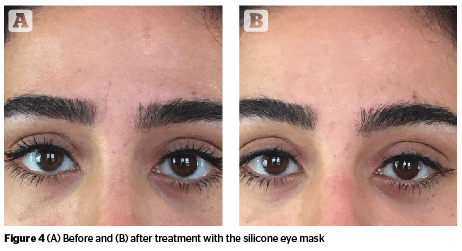
There was a significant difference in the ratings of glabellar lines at post-test between patients who wore the SEM compared to patients who wore the REM (F (1, 27) = 13.69, p = .001, ηp2 = .34), with lower scores, thus an improved appearance of glabellar lines, shown in the experimental condition (Figures 2–4). The duration of improvement was also assessed in this condition; resulting in M = 4.90 hours (SD=2.73).
It was of further interest to examine whether patients in the two conditions (SEM vs. REM) differed on their ratings of emotional relaxation after 15 minutes of wearing the respective masks. Table 2 shows the number of patients who reported feeling emotionally relaxed or those who reported not feeling emotionally relaxed by the experimental condition.
Table 2 also shows that the proportion of patients in the SEM condition who reported feeling emotionally relaxed (10 out of 15, 67%) was greater than patients who reported feeling emotionally relaxed in the REM condition (6 out of 15, 40%). A chi-square test revealed, however, no significant differences between the conditions: χ2 (1, N = 30)= 2.14, p >.05.
Discussion
To the authors’ knowledge, the SEM is the first product of its kind which specifically targets cutaneous mechanoreceptors, especially the SA types, in order to exert its effects. Various facial stick-on patches and pads exist for overnight wear to correct facial lines, however, the authors have been unable to find any scientific studies that substantiate their claims and they certainly do not target mechanoreceptors as the SEM.
This study has found that when compared to a REM, the SEM significantly reduces glabellar lines. The proposed mechanism of action is that the small raised silicone dots cause temporary small indentations in the skin that stimulate all types of facial mechanoreceptors, especially SA free nerve endings with LTP units.
Stimulation of these mechanoreceptors sends somatosensory and autonomic signals to decrease sympathetic activity. The result is a decrease in muscle tone and emotional arousal, thereby reducing facial (glabellar) lines while promoting emotional relaxation. Both effects were found in this study.
The authors recognise that there are limitations to this study. A larger group size would have provided more statistical power for more robust conclusions. While the SEM showed a significant improvement in glabellar lines compared to the REM, the reducing arousal effect did not reach statistical significance, even though there was a clear tendency toward this effect.
While every attempt was made to blind the examiners and the subjects to the treatments, both may have recognised the differences between the masks when fitting them on for the experiment. This may have introduced an element of bias toward the SEM.
These limitations notwithstanding, the study data, from both objective and subjective assessments, provided consistent results to show the SEM significantly improved glabellar lines when compared to the REM and the former also showed a greater tendency toward emotional relaxation.


